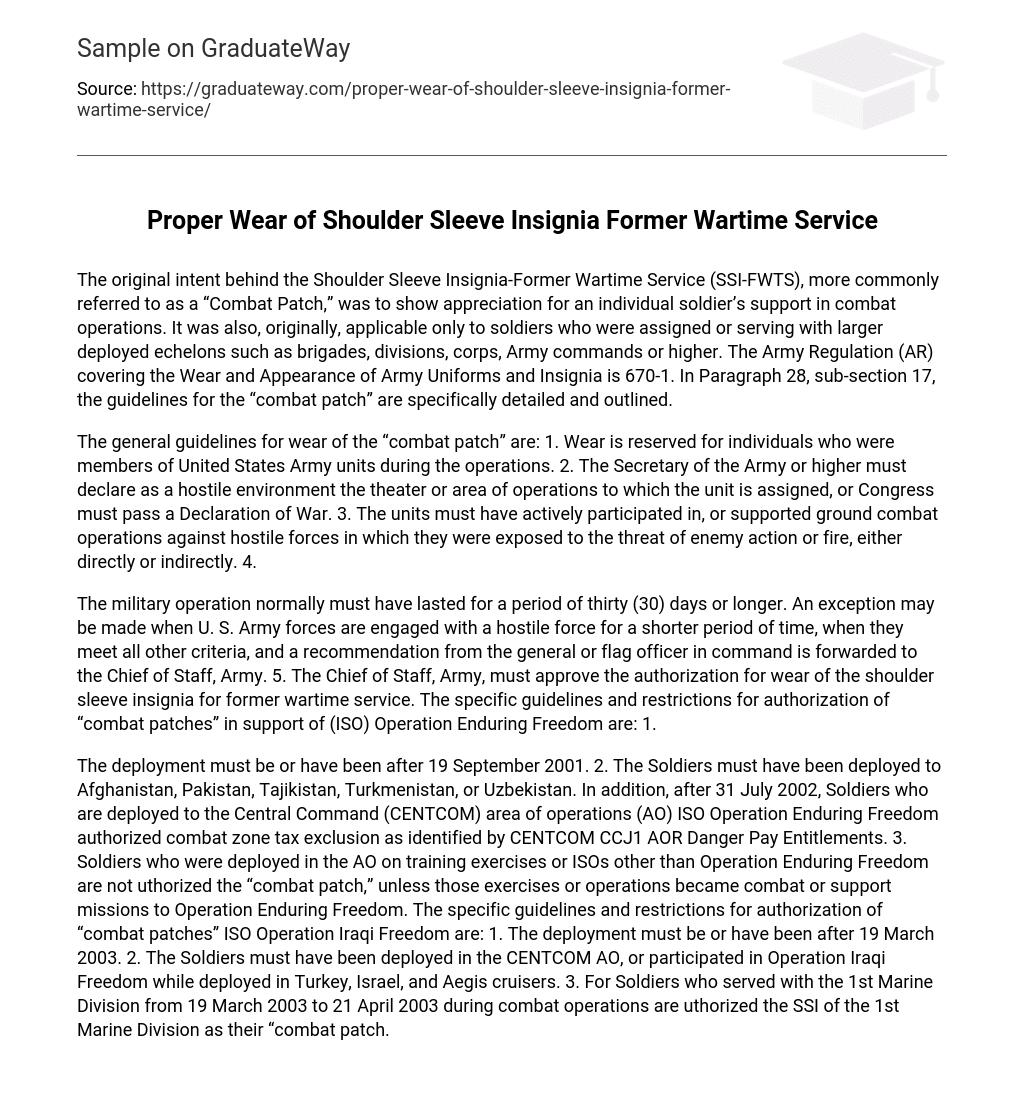The original purpose of the Shoulder Sleeve Insignia-Former Wartime Service (SSI-FWTS), also known as a “Combat Patch,” was to acknowledge a soldier’s contribution in combat operations. Initially, it was only awarded to soldiers who were part of larger deployed units like brigades, divisions, corps, Army commands or higher. The guidelines for the wear and appearance of Army uniforms and insignia are outlined in Army Regulation (AR) 670-1, specifically in Paragraph 28, sub-section 17.
The “combat patch” can be worn under specific conditions in the US Army. These conditions are as follows:
1. It is exclusively worn by individuals who have served in the Army during operations.
2. The unit’s theater or area of operations must be officially declared a hostile environment by either the Secretary of the Army or a higher authority, or Congress must pass a Declaration of War.
3. The units must have actively participated in or provided support for ground combat operations against hostile forces and have been exposed to enemy action or fire, whether directly or indirectly.
4.
The typical length of a military operation is generally thirty (30) days, unless special circumstances arise in which U.S. Army forces engage with an enemy force for a shorter duration while still meeting all criteria. In such instances, the commanding general or flag officer must recommend it to the Chief of Staff, Army. Approval from the Chief of Staff, Army is necessary for wearing the shoulder sleeve insignia as acknowledgement of past wartime service. The guidelines and limitations regarding authorizing “combat patches” in support of Operation Enduring Freedom are detailed below:
Soldiers who were deployed to Afghanistan, Pakistan, Tajikistan, Turkmenistan, or Uzbekistan after 19 September 2001 are eligible for combat zone tax exclusion. This eligibility is determined by CENTCOM CCJ1 AOR Danger Pay Entitlements for soldiers deployed to the CENTCOM area of operations (AO) in support of Operation Enduring Freedom after 31 July 2002.
However, soldiers who were deployed in the AO for training exercises or ISOs other than Operation Enduring Freedom will not be authorized the “combat patch” unless those exercises or operations turned into combat or support missions.
In order to be authorized a “combat patch” related to Operation Iraqi Freedom, soldiers must have been deployed after 19 March 2003 in the CENTCOM AO or have participated in Operation Iraqi Freedom while deployed in Turkey, Israel, and Aegis cruisers.Soldiers who served with the 1st Marine Division from 19 March 2003 to 21 April 2003 during combat operations can wear the SSI (shoulder sleeve insignia) of the 1st Marine Division as their “combat patch.” Soldiers deployed in the AO (area of operations) for training exercises or ISOs (individual support options) other than Operation Iraqi Freedom will not be allowed to wear the “combat patch” unless those exercises or operations turned into combat or support missions for Operation Iraqi Freedom. Sergeant Major Katrina Easley, who is responsible for uniform policy at Army G-1 and also serves as the point of contact for ALARACT 55-2007, which is an update to AR (Army Regulation) 670-1 regarding “Combat Patches,” explained that soldiers now deploy in smaller units like companies, battalions, and combat brigade teams, as well as individuals supporting larger units. At these levels, they are not permitted to wear their unit patch as a combat patch. The ALARACT was published on March 28, 2007 and aims to clarify and modify the regulation by stating that “the wear policy for the SSI-FWTS (shoulder sleeve insignia-former wartime service) must be revised to accurately represent the wartime association with ground fighting units.”
This policy change is effective immediately and is not retroactive. In addition, the policy change and guidance is applicable to Soldiers of all components that deploy during periods of service designated for wear of the SSI-FWTS, in accordance with AR 670-1, Paragraph 28-17. Originally, for a Soldier to be authorized to wear a “combat patch”, the regulation required a minimum of thirty days in the specified combat zone before approval of a “combat patch” could be authorized for wear.
According to the new guidance, there is no longer a time-in-theater requirement to wear the SSI-FWTS. When a Soldier is first assigned or reassigned to a new unit, they must wear the specific patch of that command on their left sleeve. Under the new guidance, Soldiers deployed to a designated combat zone are now allowed to wear the patch of the company-level or higher that they serve with on their right sleeves.
The authorization of a “combat patch” is no longer determined by the deploying Unit’s Headquarters element. It also doesn’t matter how many times the Units alignment or Operational Control (OPCON) changes during deployment. When a element below the Company level is deployed, the Soldiers assigned to that element must now wear the “combat patch” of the lowest echelon in their new deployed Chains of Command. The only restriction is that the lowest echelon must be at the Company level or above.
When there is no intermediate unit at the Company level or higher, deployed Soldiers will wear the “combat patch” of the “Senior Army Command in the Theater”. This ALARACT includes a clarification on which “combat patch” should be worn. There was confusion about “Soldiers who are cross-leveled, assigned, attached or serving as augmentees to deployed units” and “Soldiers who are temporary duty (TDY) on orders through the use of DD Form 1610 (Request and Authorization for TDY Travel of DOD Personnel)” in a combat zone.
The latest guidance specifies that if Soldiers meet the criteria mentioned above, they will wear the same “combat patch” as the unit they are attached or OPCON to. This change does not apply to Trial Defense and CIDC members, who will wear their respective command’s SSI as their “combat patch.”





